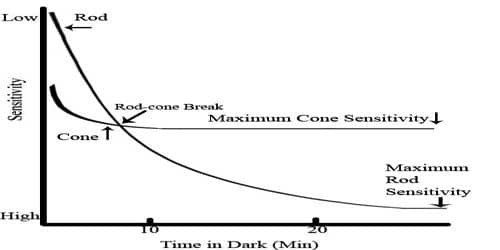Dark Adaptation
After entering from a brightly illuminated area into a dark area the vision at first is very poor but after sometimes the vision is improved. This is known as adaptation. It happens when going from a well light area to a dark area. Primarily blackness is seen because our cones stop functioning in low concentration light. It is the procedure including dilation of the pupil; enlarge insensitivity of the retinal rods and renaissance of rhodopsin by which the eye adapts to conditions of reduced illumination. Dark adaptometry is useful in evaluating night blindness. It can also help in evaluating cone dysfunction syndromes by indicating the degree of cone adaptation.
The time required: Time taken for dark adaptation is directly proportional to the intensity of light and duration of exposure and inversely proportional to vitamin-A content.
Mechanism
If a Person has been in bright light for a long time large proportions of his photo chemicals in both rods and cones are decomposed. So the sensitivity of pertaining is very low on entering the darkness immediately vita-A invents into the retina and all pertinent steps on gradually perform photosensitive component (photopia) and pupil also dilates so the retinal sensitivity to light inebriates and the person can see all things. During this adaptation process, reflexive changes occur in the pupil size. At the end of dark adaptation, the eye is about 100,000 times (i.e., 5 log units) more sensitive than it was at the beginning of the test, a level called dark-adapted sensitivity.












